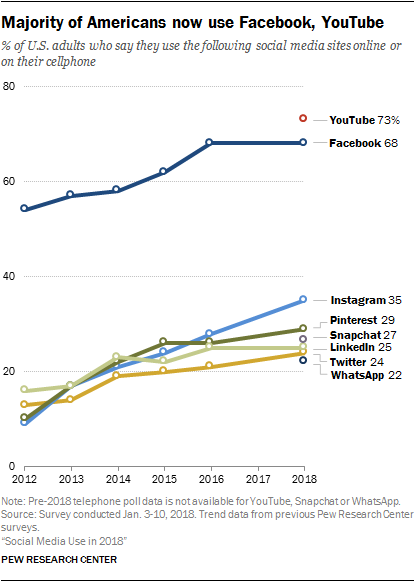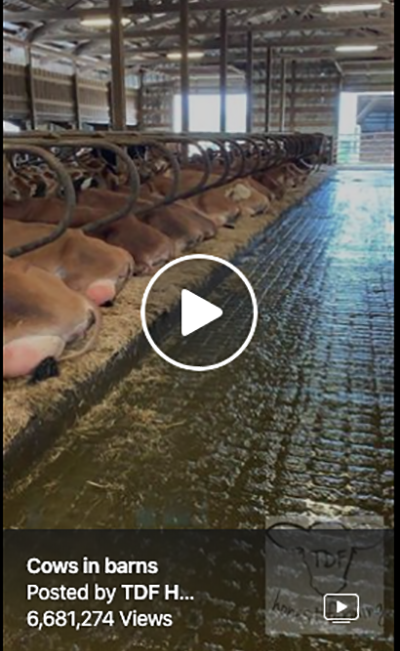Last week I taught class of high school juniors and seniors about marketing, and we were discussing where their target audience would be using social media. When we talked about the demographics of social media, I asked where they would find people of my age (40 to 50 years old). Almost in unison, they shouted, "Facebook!"
And they are correct. If you are looking to reach the majority of Americans and if you are looking for the place they spend the most time (38 minutes a day), it's Facebook, and those percentages are by a wide margin.
What can you post nowadays that will help you show up in the Facebook feed of your target audience and not just your ag-related friends? Because the Facebook algorithm is most likely going to show only the posts you like or agree with, it's going to be hard to reach the people that you actually want to showcase your farm to and answer their questions.
Here’s a top list of items to post on your Facebook farm page:
1. Post videos of animals and your farm life
I've been teaching for years that video is the best way to share your farm life story, and it still is the number one way.
What should you film?
A. The animals: People love the animals, and you are the expert caretaker of those animals. Talk about why you love them, what you do to care for them, and how you are doing it. The more authentic you are, the better.
B. The farm employees and equipment: You should always ask employees if they would like to be filmed, and then showcase how they are doing their work. Many of our consumers are worried that farm employees are not being taken care of; you can help end those myths.
C. The farm equipment: People are mesmerized by the large and small equipment you use. Consider how often people stop to watch construction crews. Most people don't do the kind of work you do.
D. The land: Wide-open spaces are not found in most cities, so showcasing the beauty of the landscapes you see on a daily basis can get people to slow down in their Facebook feed scrolling. It's also an opportunity for you to talk about how you take care of the land for future generations.
Top Tip: Use the VideoShow or Video Shop app to edit your videos and add text to the video. Remember between seventy to ninety percent of all video is viewed with the sound off.
2. Post photos of animals and your farm life
If you can’t do video, then it’s always good to have a photo or a series of photos with your post. It helps for visibility in others’ Facebook feed and gives people an idea of how a modern farm looks today.
Top Tip: Add your farm logo or name to your video or photo before posting. While you always own the copyright, it lets your farm brand travel with the photo as people share it. Phonto, Canva, or Wordswag are my favorite apps for adding logos or putting text over photos.
3. Engage in the Facebook comments
Sometimes this can take the most time with social media, but the comments are probably the most important thing you can do to help your Facebook page be seen and relevant to Facebook's algorithm. Comments keep posts alive and help more people see your videos or photos.
Top Tip: Tough questions may be scary but many times they can be over in seconds. Here are three steps to handling a tough question:
A. Always check their profile to see if the inquirer is an activist. If they are, you can block and delete. No need to waste your time.
B. Ask clarifying questions so you know exactly what they are asking.
C. Craft your answer using common ground and your values. Always take the high road and remember you don't always have to agree.
3. Join Facebook groups outside of your ag circles
Facebook groups are where the majority of people are talking and sharing. If you join groups (as yourself or your Facebook farm page) outside of agriculture, you will find that you'll be able to reach more people and answer more questions about dairy and agriculture once they discover you are a farmer.
For instance, I'm in groups about motorcycles, the Navy, our local community, and exercise. I'm passionate about these things, but I'm also a trusted expert in dairy who can connect people with farmers.
4. Use Facebook advertising
Facebook’s boosted posts are a powerful way to reach consumers that are outside of your immediate regional area. You can select the audience you want to reach (for example, women ages 22 to 60 living in the closest urban city) for a relatively low cost depending on the number of followers you have. (For around $5, you can reach about 1,000 people or more.)
I’ve found that boosting posts early can help more people see it.
BONUS TIP — Do your best to watch for trends that occur in the news and tie your posts back to what’s happening in the news cycle. For example, as we get closer to winter, people will talk about the cold and the holidays. You could address both topics in how you keep yourself and the animals protected from the elements. With the holidays, you could talk about which dairy products your family enjoys at family gatherings.
I keep a running list of Facebook farm pages on my website. If you would like to be added to this list, please email me at don.schindler@dairy.org.
Do you need help getting started in social media and connecting with consumers via digital tools? Your local and national dairy checkoff can help — please reach out to them via dairy.org or me at don.schindler@dairy.org. If you would like to learn more about your national dairy checkoff, you can join our Facebook group or visit dairy.org for information.

The author is a Senior Vice President of Digital Initiatives at Dairy Management Inc.










